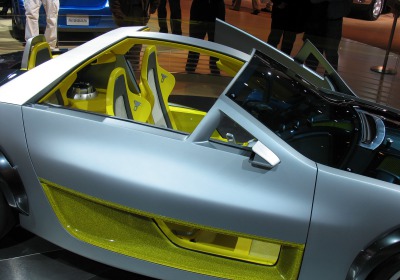Essay: Variable Degrees of Translucency
Mon, 12 Nov 2007Car door panels and fenders are generally made of steel, sometimes of aluminum or plastic composites, and you can't see through them. Car windows, on the other hand, are made of a transparent sandwich of glass and plastic - and you can see through them. But in the future there will be variable degrees of transparency: translucent elements where once there were none, traditional window areas that will have opaque elements and graduated progressions from opaque to see-through. This was evidenced on the Bertone-designed Lancia Sibilo concept from 1978, which had a dark brown body feathered into a heavily tinted glasshouse.
For the most part this new trend for translucency will be afforded by new polycarbonate plastics from suppliers such as Freeglass and Sabic Innovative Plastics (formerly GE Plastics). Several production cars already such have plastic glazing elements, the European market Honda Civic has a plastic glazing element as the lower part of the rear window, and the European market SEAT Leon has a plastic third side light incorporating a recess for the hidden rear door handle. Roof glazing is the next major area that is likely to feature plastic composites, as the intrinsic weight saving has such a particular benefit on the car's center of gravity.
But we will soon see more translucencies in cars driven by design, not just technical possibility. Translucency has the potential to make a more distinctive design and to offer new user benefits, such as enabling the driver to see the curb when parking, see through pillars when making lane changes and also enable children and shorter occupants to better see out of cars. There are a host of far more appealing ideas which can be incorporated as well.
Here are several recent concept cars that show how Design has innovated using variable degrees of translucency:
The Hyundai Qarmaq (inspired by the sixties Bertone Marzal concept), Citroën C-Airplay, and Nissan Urge and Roundbox use glazing in the lower side of their doors to create more distinctive exterior and interior designs. Various Mazda concepts, including the Sassou and Taiki, have lighting that shines through apparently opaque body colored exterior surfaces - so during the day (with lights off) the exterior has a cleaner aesthetic, and its night-time appearance is noticeably different.
The rear tailgate that closes over the rear lights on the Citroën C-Cactus makes a red translucent 'porthole' inside the ring of LED rear lights. This enables people to see in and out of the cabin in a novel way. The Smart FourFour Style concept has translucent plastic doors and hood panels to expose some of the under-skin structure of the car and essentially blur the boundary between exterior and interior surfaces, while the Opel Flextreme has a transparent cover to its grille aperture - and also over its alloy wheel spokes - to aid its aerodynamics whilst preserving the visual impression of these apertures.
These concepts illustrate just the 'tip of the iceberg', but there will be a multitude of new and creative translucent solutions provided by variable degrees of translucency, far more than the practical benefits of new glazing applications.
Related Stories:
Design Review: Hyundai Qarmaq
Design Review: Citroën C-Cactus
2007 Tokyo Motor Show Highlights
By Sam Livingstone



